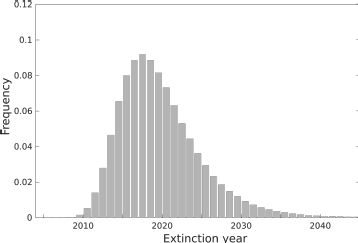Stochastic Modelling
Through the work of the NTD Modelling Consortium, the team have worked to develop a stochastic version of the gHAT dynamic model. In the the Warwick gHAT model, individual humans are assigned to different compartments associated with infection/disease status. In the stochastic version the dynamics are described between different compartments by random events captured by a tau-leap approximation for continuous event rates (infections, passive detections). Active screening is simulated at the beginning of each year with case detections drawn from probability distributions. The vector dynamics are kept the same as the original model, described by a set of ODEs.
The average of many stochastic realisations follows the mean solutions described by the deterministic model, however individual ones express divergent behaviours.
 The left figure shows the stochastic realisations of the model using the same parameter sets. The number of new transmissions is shown over time for six individual realisations (the coloured lines) and the mean of a thousand realisations (the black solid line).
The left figure shows the stochastic realisations of the model using the same parameter sets. The number of new transmissions is shown over time for six individual realisations (the coloured lines) and the mean of a thousand realisations (the black solid line).
The stochastic model comes with a good deal of flexibility and capabilities that we take advantage of to understand the endpoint of sleeping sickness. Since the number of humans are integer values in this framework, they can reach zero and allow the expected time to extinction to be calculated.
 Divergence behaviour of individual simulations leads to various extinction times even in the same conditions, that we can show with a probability distribution of extinction times.
Divergence behaviour of individual simulations leads to various extinction times even in the same conditions, that we can show with a probability distribution of extinction times.
The right figure shows an example of the probability distribution of extinction times in the stochastic gHAT model for one parameter set and 1 million realisations.

HAT Project Team
Principal Investigators:
Kat Rock and Matt Keeling
Warwick project team:
Simon Spencer
Maryam Aliee
Chris Davis
External project team:
Nakul Chitnis (Swiss TPH)
Soledad Castaño (Swiss TPH)
Deirdre Hollingsworth (Oxford)

